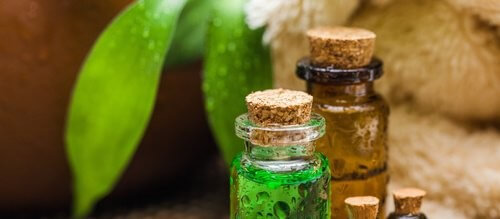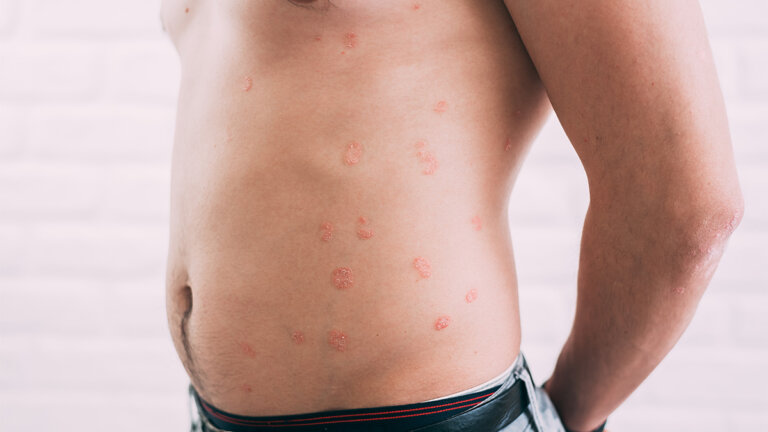Tea Tree Oil: The Oil of a Thousand Remedies


Written and verified by psychologist Valeria Sabater
Tea tree oil has been used to treat skin problems for centuries. However, its medicinal uses go further than this. Interestingly, tea tree oil originally comes from Australia. This is where it first started to be used thanks to the steam distillation of leaves from a tree called Melalueca Alternifolia.
The Aboriginal Australians have always used it to treat a variety of conditions, ranging from skin problems to respiratory issues. Today, the pharmaceutical and aromatherapy industries regularly use tea tree oil because of its many benefits. Have you tried it yet? We’ll discover some of its main uses in this article.
Tea Tree Oil Helps Treat Acne
A perfect way to get rid of persistent acne or black heads is to use tea tree oil. Its antibacterial and antifungal properties are ideal to combat this common skin complaint. However, remember that you shouldn’t apply this oil directly to the skin. To avoid irritation, it’s best to dilute it before use.
While a study carried out by the Medical University of Taipei has confirmed the antifungal properties of tea tree oil, it also claims that it’s only effective in treating acne in about 5% of cases.
How to Use and Apply Tea Tree Oil for Acne

Proportions
- 2 drops of tea tree oil
- 10 drops of water
- 5 drops of witch hazel
How to use it
- Combine all the ingredients to obtain a lotion, Then, simply apply to problem areas with a cotton pad. Use twice daily.
Tea Tree Oil Helps to Weaken Dry Nail Cuticles
This natural product has many cosmetic uses. One of them is that it is said to weaken chapped and unequal nail cuticles (although there is no scientific evidence proving this). Tea tree oil also helps to treat fungal nail infections, as confirmed in this investigation conducted by the University of Canberra (Australia).
How to Use and Apply it
- Apply a few drops of tea tree oil to a cotton pad and rub it over your cuticles. After a few minutes, you’ll see how it is easy to eliminate them
- If you’re suffering from a fungal nail infection, add 5 drops of tea tree oil to your nail polish, and apply 3 times a week.
Tea Tree Oil to Treat Pityriasis Rosea

Its origin is infectious and treatment, in many cases, is limited to corticosteroids. However, despite what many believe, there is no scientific evidence to prove the effectiveness of tea tree oil in relieving this condition.
How to Use it
The dose of this type of oil should always be more or less 5% of the amount of water that you use.
- So, for example, you can prepare a fresh half glass of water (100 ml) and add 5 ml of tea tree oil.
- If you suffer from pityriasis, you should clean the affected area before applying the diluted tea tree oil. Massage the area with this mixture everyday. Little by little, you will start to see positive results.
Using Tea Tree Oil to Treat Athlete’s Foot
Athlete’s food is caused by a specific type of fungus. This fungus thrives in warm and humid places, and lives in dead skin tissue. It’s very common to experience swelling or flaking of the skin, on the sides of your feet as well as in the area between the toes.
According to information by the Mayo Clinic, one way to treat this condition is to use tea tree oil. Thanks to its antimycotic properties, it can slow down fungal growth and promote skin healing. Below, we’ll explain how to achieve this result.
How to Use it
- Fill the bathtub with warm water.
- Add 10 drops of tea tree oil and 10 drops of rosemary oil to the water.
- Put your feet in the bath for 20 minutes. Then, dry them carefully, and don’t forget to dry the area between your toes. Repeat this every day when you get home.
Tea Tree Oil is a Natural Mosquito Repellent

This remedy has been proven by a study carried out by the New Mexico State University. If you live in a very humid area, you run the risk of being attacked by mosquitoes. Seeing as organic repellents or using a specific type of clothing aren’t always enough to repel mosquitoes, we suggest you do the following.
A combination of tea tree oil and water can be used to create your own insect repellent. Though you may find it difficult to believe, the aroma and properties of this oil can help to protect the skin against insect bites.
Ingredients
- 5 tablespoons of water (50ml)
- 10 drops of tea tree oil
- 10 drops of citrus or essential lemon oil
How to Make it
- In order to create this mixture you will need to use a bottle that has an oil diffuser. After this, you should apply this mixture to your skin every night before you go to bed. It’s a great and cheap repellent, and is worth always having in your house.
Already got some tea tree oil in your first aid kit? Now that you know all its properties and uses, don’t hesitate to pick some up at your local pharmacy or herb store. You’ll love it!
All cited sources were thoroughly reviewed by our team to ensure their quality, reliability, currency, and validity. The bibliography of this article was considered reliable and of academic or scientific accuracy.
- Del Beccaro M (1995). “Melaleuca oil poisoning in a 17-month-old.”. Vet Hum Toxicol 37 (6): 557-8. PMID 8588296.
- Carson CF, Hammer KA, Riley TV. Melaleuca alternifolia (tea tree) oil: a review of antimicrobial and other medicinal properties. Clin Microbiol Rev. 2006;19:50-62.
- Cox, S. D., Mann, C. M., Markham, J. L., Bell, H. C., Gustafson, J. E., Warmington, J. R., & Wyllie, S. G. (2000). The mode of antimicrobial action of the essential oil of Melaleuca alternifolia (Tea tree oil). Journal of Applied Microbiology. https://doi.org/10.1046/j.1365-2672.2000.00943.x
- Murbach Teles Andrade, B. F., Nunes Barbosa, L., Da Silva Probst, I., & Fernandes Júnior, A. (2014). Antimicrobial activity of essential oils. Journal of Essential Oil Research. https://doi.org/10.1080/10412905.2013.860409
This text is provided for informational purposes only and does not replace consultation with a professional. If in doubt, consult your specialist.








